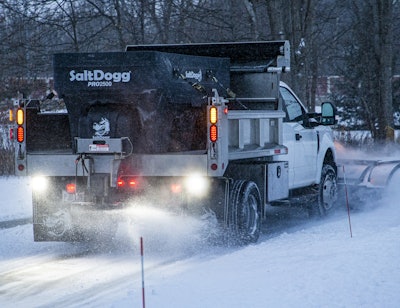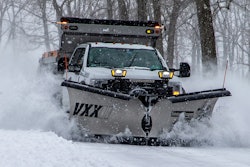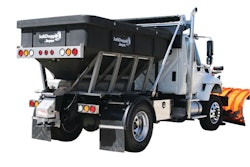
A salt spreader is a necessary addition to your fleet come wintertime. From an efficiency standpoint, salt spreaders maximize your fleet’s capabilities. By adding salt spreaders to your fleet, you’re adding more tools to your arsenal, making for a more valuable bid. Combat heavy wintry travel conditions by applying salt to road surfaces quickly and efficiently, while expanding your fleet’s offerings at the same time.
Salt spreaders require much less effort than manually sowing rock salt, saving time, resources and energy. Overall, salt spreaders have proven to be a valuable investment for communities and municipalities that experience snowy or icy conditions. Here are five questions to help you find the best salt spreader to serve your fleet’s needs.
1. What is the size of the area that needs to be covered?
The size of the area to be covered is an important factor to consider when selecting a salt spreader. If the area is large, you may need a larger capacity spreader that can cover more ground in less time.
2. What type of material will you be spreading?
Salt spreaders can be used to spread various materials such as salt, sand and gravel. Depending on the type of material you will be spreading, you may need a spreader with specific features such as a larger hopper or a different type of agitator. If you opt for a spreader with a swing-away chute design, bulk unloading of any material will be a breeze. The swing-away chute, tool-free and easy to use, also offers unobstructed access to the hitch.
3. What type of vehicle will the spreader be attached to?
Salt spreaders can be attached to a variety of vehicles including trucks, SUVs, ATVs, tractors and skid-steers. The type of vehicle you’ll be operating will determine the size and weight of the salt spreader that you can use.
Take trucks, for example. You’ll want to make sure you don’t exceed the gross vehicle weight (GVW) of your truck. The weight of the spreader counts toward the GVW (as does a snow plow, should you have one installed on your truck). You not only have to consider the weight of the spreader empty, but you must consider the weight of the unit with the material inside. There can be a big difference between wet and dry material. Salt and sand can weigh significantly more wet than dry.
 Before purchasing a salt spreader, snow pros must take into consideration the weather conditions in their area.Buyers Products
Before purchasing a salt spreader, snow pros must take into consideration the weather conditions in their area.Buyers Products
4. What is your budget?
Salt spreaders can range in price from a few hundred dollars to $10,000-plus. It is important to consider your budget when selecting a salt spreader. The drive option you select for your salt spreader (gas, electric or hydraulic) certainly factors into the cost. Gas engine spreaders were long considered the most common, though electric spreaders have increased in popularity in recent years. With an electric spreader, you eliminate worries about the fuel going bad or carburetors clogging up. Not to mention, they are much quieter. The gas engines are quite loud, especially when operated in neighborhoods. Gas and electric spreaders are found at a similar price point, though consider these couple of perks with electric spreaders: You don’t have to purchase any fuel, and you don’t have to winterize the spreader.
Another cost-effective measure when considering a salt spreader is to add in a prewet system. Optional prewet (or ice-melting) agents are becoming more and more popular with municipal, commercial and residential jurisdictions, as they activate the salt in lower temperatures to keep it working. A prewet system makes salt sticky, as opposed to the typical hard and bouncy, which has ramifications you may not necessarily think of. Hard, bouncy salt, when it drops out of the chute, doesn’t always stay on the road. Salt leaving the roadways often ends up disturbing vegetation and contaminating fresh groundwater. By prewetting granular salt, you can reduce salt consumption by 30 percent. This saves an astounding amount of money over time.
5. What are the weather conditions in your area?
The weather conditions in your area can impact the type of salt spreader you need. If you live in an area with heavy snowfall, you may need a spreader with a higher capacity and more durable construction. If you live in an area with milder winters, a smaller spreader may suffice.
The weather conditions you’ll be operating in can also help determine whether an auger or chain drive system would be best for you. For instance, with heavier storm conditions, the wider feed mechanism of the chain drive moves more material through. If you live in a less extreme climate, the auger drive has fewer moving parts, making it much easier to maintain.
In extreme cold or wet material conditions, you may experience “bridging,” which doesn’t allow the salt to flow through the chute. It’s a good rule of thumb to ensure you’re running a vibrator with your spreader at all times, which keeps the salt, sand or gravel from freezing up.
Accessories
Aside from just the spreader unit, there are many accessories to consider, as well. By installing a tarp or hard-shell lid, the material inside your spreader is protected from rain or snow. Tarps are generally more forgiving (and the more affordable option); hard-shell lids won’t close shut if your spreader is mounded with material.
While a v-box spreader installed on a truck can limit the driver’s visibility, a backup camera mitigates some of the visibility concerns. You’ll want to be sure to wipe it clean regularly, though, as salt can cloud its face. A leg stand makes unloading your spreader from the truck a much easier, one-person job. While you’ll most likely keep the spreader installed during the busy months, you may want to unload the spreader during the offseason or whenever it’s not needed.
Taking into consideration the five questions outlined will go a long way in determining the best salt spreader for your fleet. Most of today’s spreaders are constructed of tough, durable stainless steel or polymer, making the units worthwhile investments. Maximize your fleet’s capabilities and increase its value and demand by equipping your trucks with salt spreaders come next winter.




![Doosan Bobcat Wacker Neuson Stack 2ec Js Pb V6e[1]](https://img.greenindustrypros.com/mindful/acbm/workspaces/default/uploads/2025/12/doosan-bobcat-wacker-neuson-stack2ecjspbv6e1.CPyyz8ubHn.png?auto=format%2Ccompress&bg=fff&fill-color=fff&fit=fill&h=100&q=70&w=100)







![Doosan Bobcat Wacker Neuson Stack 2ec Js Pb V6e[1]](https://img.greenindustrypros.com/mindful/acbm/workspaces/default/uploads/2025/12/doosan-bobcat-wacker-neuson-stack2ecjspbv6e1.CPyyz8ubHn.png?ar=16%3A9&auto=format%2Ccompress&bg=fff&fill-color=fff&fit=fill&h=135&q=70&w=240)

![Gravely Pro Turn Mach One My23 Dsc03139 Edit 1200x800 5b2df79[1]](https://img.greenindustrypros.com/mindful/acbm/workspaces/default/uploads/2025/10/gravely-pro-turn-mach-one-my23-dsc03139-edit-1200x800-5b2df791.BucBnDoN22.jpg?ar=16%3A9&auto=format%2Ccompress&fit=crop&h=135&q=70&w=240)


![Kubota Snow ah3 Sgv25ua[1]](https://img.greenindustrypros.com/mindful/acbm/workspaces/default/uploads/2025/10/kubota-snowah3sgv25ua1.bAUoUSziui.png?ar=16%3A9&auto=format%2Ccompress&bg=fff&fill-color=fff&fit=fill&h=135&q=70&w=240)


